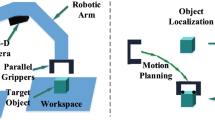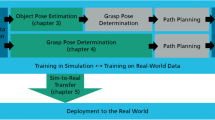Abstract
Object grasping is a typical human ability which is widely studied from both a biological and an engineering point of view. This paper presents an approach to grasp synthesis inspired by the human neurophysiology of action-oriented vision. Our grasp synthesis method is built upon an architecture which, taking into account the differences between robotic and biological systems, proposes an adaptation of brain models to the peculiarities of robotic setups. The architecture modularity allows for scalability and integration of complex robotic tasks. The grasp synthesis is designed as integrated with the extraction of a 3D object description, so that the object visual analysis is actively driven by the needs of the grasp synthesis: visual reconstruction is performed incrementally and selectively on the regions of the object that are considered more interesting for grasping.
Similar content being viewed by others
References
Arimoto, S., Yoshida, M., & Bae, J.-H. (2006). Stable “blind grasping” of a 3D object under non-holonomic constraints. In Proceedings IEEE international conference on robotics and automation (pp. 2124–2130), Orlando, FL, USA, May 2006.
Arkin, R. C. (1998). Behavior-based robotics. Intelligent robotics and autonomous agents series. Cambridge: MIT Press.
Bicchi, A., & Kumar, V. (2000). Robotic grasping and contact: a review. In Proceedings IEEE international conference on robotics and automation (pp. 348–353), April 2000.
Borst, C., Fischer, M., & Hirzingerm, G. (1999). A fast and robust grasp planner for arbitrary 3D objects. In Proceedings IEEE international conference on robotics and automation (pp. 1890–1896), Detroit, MI, USA, May 1999.
Borst, C., Fischer, M., & Hirzinger, G. (2000). Grasp planning: how to choose a suitable task space. In Proceedings IEEE international conference on robotics and automation (pp. 319–325), New Orleans, LA, USA, April 2004.
Brooks, R. (1999). Cambrian intelligence: the early history of the new AI. Cambridge: MIT Press.
Bullier, J. (2001). Integrated model of visual processing. Brain Research Reviews, 36(2–3), 96–107.
Castiello, U. (2005). The neuroscience of grasping. Nature Reviews Neuroscience, 6(9), 726–736.
Chaumette, F., Boukir, S., Bouthemy, P., & Juvin, D. (1996). Structure from controlled motion. IEEE Transactions on Pattern Analysis and Machine Intelligence, 18(5), 492–504.
Chinellato, E., Demiris, Y., & del Pobil, A. P. (2006). Studying the human visual cortex for achieving action-perception coordination with robots. In IASTED international conference on artificial intelligence and soft computing (ASC 2006).
Chinellato, E., Morales, A., Fisher, R. B., & del Pobil, A. P. (2005). Visual features for characterizing robot grasp quality. IEEE Transactions on Systems, Man and Cybernetics, Part C, 35(1), 30–41.
Culham, J. (2004). Human brain imaging reveals a parietal area specialized for grasping. In N. Kanwisher & J. Duncan (Eds.), Functional neuroimaging of visual cognition: attention and performance XX (pp. 417–438), Oxford: Oxford University Press.
Fagg, A. H., & Arbib, M. A. (1998). Modeling parietal-premotor interactions in primate control of grasping. Neural Networks, 11(7–8), 1277–1303.
Goldfeder, C., Allen, P., Pelossof, R., & Lackner, C. (2007). Grasp planning via decomposition trees. In Proceedings IEEE international conference on robotics and automation (pp. 4679–4684), Rome, Italy, April 2007.
Goodale, M. A., & Milner, A. D. (1992). Separate visual pathways for perception and action. Trends in Neurosciences, 15(1), 20–25.
Goodale, M., & Milner, D. (2004). Sight unseen. Oxford: Oxford University Press.
Grefkes, C., Weiss, P. H., Zilles, K., & Fink, G. R. (2002). Crossmodal processing of object features in human anterior intraparietal cortex: an fMRI study implies equivalencies between humans and monkeys. Neuron, 35(1), 173–184.
Hauck, A., Rüttinger, J., Sorg, M., & Färber, G. (1999). Visual determination of 3D grasping points on unknown objects with a binocular camera system. In Proceedings IEEE/RSJ international conference on intelligent robots and systems (pp. 272–278), Korea: Kyongju.
James, T. W., Humphrey, G. K., Gati, J. S., Menon, R. S., & Goodale, M. A. (2002). Differential effects of viewpoint on object-driven activation in dorsal and ventral streams. Neuron, 35(4), 793–801.
Jeannerod, M., Arbib, M. A., Rizzolatti, G., & Sakata, H. (1995). Grasping objects: the cortical mechanisms of vasomotor transformation. Trends in Neurosciences, 18(7), 314–320.
Johansson, R. S., & Westling, G. (1984). Roles of glabrous skin receptors and sensorimotor memory in automatic control of precision grip when lifting rougher or more slippery objects. Experimental Brain Research, 56(3), 550–564.
Kragić, D., Crinier, S., Brunn, D., & Christensen, H.I., (2003). Vision and tactile sensing for real world tasks. In Proceedings IEEE international conference on robotics and automation (pp. 1545–1550), Taipei, Taiwan, September 2003.
Lopez-Damian, E., Sidobore, D., & Alami, R. (2005). Grasp planning for non-convex objects. In Proceedings of the 36th international symposium on robotics, Tokyo, Japan, November 2005.
Mendonça, P. R. S., Wong, K.-Y. K., & Cipolla, R. (2001). Epipolar geometry from profiles under circular motion. IEEE Transactions on Pattern Analysis and Machine Intelligence, 23(6), 604–616.
Michel, C., Perdereau, V., & Drouin, M. (2005). Extraction of the natural grasping axis from arbitrary 3D envelopes provided by voxel coloring. In Proceedings of the 36th international symposium on robotics, Tokyo, Japan, November 2005.
Miller, A. T., Knoop, S., Christensen, H. I., & Allen, P. K. (2003). Automatic grasp planning using shape primitives. In Proceedings IEEE international conference on robotics and automation (pp. 1824–1829), Taipei, Taiwan, September 2003.
Natale, L., & Torres-Jara, E. (2006). A sensitive approach to grasping. In Proceedings sixth international conference on epigenetic robotics, Paris, France, September 2006.
Platt, R., Fagg, A. H., & Grupen, R. A. (2002). Nullspace composition of control laws for grasping. In Proceedings IEEE/RSJ international conference on intelligent robots and systems (pp. 1717–1723), Lausanne, Switzerland, October 2002.
Ponce, J., Stam, D., & Faverjon, B. (1993). On computing force-closure grasps of curved two dimensional objects. The International Journal of Robotics Research, 12(3), 263–273.
Recatalá, G., Chinellato, E., del Pobil, A.P., Mezouar, Y., & Martinet, P. (2006a). 3D grasp synthesis based on a visual cortex model. In Proceedings of the first IEEE/RAS-EMBS international conference on biomedical robotics and biomechatronics, Pisa, Italy, February 2006.
Recatalá, G., Sanz, J., Cervera, E., & del Pobil, A. P. (2006b). Visual servoing for the tool-to-object positioning with respect to welding points. In P. Drews (Ed.), Mechatronics & Robotics’04 (Vol. III, pp. 1241–1246), Aachen, Germany, September 2004. Aachen: Sascha Eysoldt.
Yerry, M. A., & Shepard, M. S. (1983). A modified quadtree approach to finite element mesh generation. IEEE Computer Graphics and Applications, 3(1), 39–46.
Zeng, G., Paris, S., Lhuillier, M., & Quan, L. (2003). Study of volumetric methods for face reconstruction. In IEEE intelligent automation conference.
Zöllner, R., Pardowitz, M., Knoop, S., & Dillmann, R. (2005). Towards cognitive robots: building hierarchical task representations of manipulators from human demonstration. In Proceedings IEEE international conference on robotics and automation (pp. 1547–1552), Barcelona, Spain, April 2005.
Author information
Authors and Affiliations
Corresponding author
Additional information
This work has been partially supported by Generalitat Valenciana (GV05/137, CTIDIA/2002/195), by Fundació Caixa-Castelló (P1-1A2003-10 and mobility fund 05I006.30) and by the Ministerio de Educación y Ciencia (DPI2001-3801, DPI2004-01920, FPI grant BES-2002-2565).
Rights and permissions
About this article
Cite this article
Recatalá, G., Chinellato, E., del Pobil, Á.P. et al. Biologically-inspired 3D grasp synthesis based on visual exploration. Auton Robot 25, 59–70 (2008). https://doi.org/10.1007/s10514-008-9086-7
Received:
Accepted:
Published:
Issue Date:
DOI: https://doi.org/10.1007/s10514-008-9086-7




